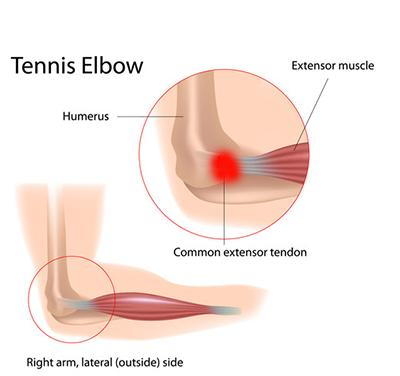Tennis Elbow treatment Shockwave therapy
posted: May 03, 2022.
Tennis Elbow
Lateral epicondylitis, often referred to as tennis elbow, is a condition in which the outer part of the elbow becomes painful. This can be due to acute or chronic inflammation of the tendons that join the forearm extensor muscles on the outside of the elbow to the bone at the lateral epicondyle. Runge (1873) is usually credited for the first description of the condition but the term 'tennis elbow' first appeared in an 1883 paper by Major called Lawn-tennis elbow.

Success rates for extracorporeal shockwave therapy (ESWT) range from 68% to 91% (Furia, 2005, Ko, Chen & Chen, 2001, Ozturan et al., 2010, Radwan et al., 2008, Rompe et al., 2004, Rompe et al., 1997, Spacca, Necozione & Cacchio, 2005).
Rompe et al (1996) reported good or excellent outcomes in 48% of patients with chronic tennis elbow and an acceptable result in 42% (at 24 weeks).
Wang & Chen (2002) in a longer study (12 to 26 months) found patients to be pain free in 61.4% of cases, significantly better in 29.5%, slightly better in 6.8% and unchanged in 2.3%.
Several studies have reported no effect of ESWT or less effect compared to placebo (Buchcinder et al, 2005, Haake et al., 2002, Haake et al, 2002, Melikyan et al., 2003, Speed et al. 2002, Staples et al., 2008).
In a review of 9 placebo-controlled trials, Buchbinder et al (2006) concluded that there is little or no benefit in terms of pain and function in lateral elbow pain, whilst there was some evidence that steroid injection may be more effective than ESWT (Buchbinder et al, 2006, Buchbinder et al, 2005).
Haake et al. (2002) in a review of 20 studies concluded that no clinically relevant efficacy has been proven for the use of ESWT for lateral elbow pain.
Speed et al. (2002) in a double blind randomized trial concluded that there appears to be a significant placebo effect of moderate dose ESWT in subjects with lateral epicondylitis, but there is no evidence of added benefit of treatment when compared to sham therapy.
So why the differences?
The differences can be attributed to patient selection, the application techniques, the type of devices, and the method of outcome measurements according to Wang (2012).
Despite the controversy in the literature shockwave offers a treatment option that has been shown to be effective in the bulk of the published studies. Together with limited side effects and in chronic patients, what is the worst that can happen? They don't improve! They weren't improving anyway!!!
As treating tennis elbow can be exquisitely painful low to medium energies have normally been used at moderate to high frequency.
Settings: Anywhere from 1.4 bar or 75mj up to 3.0 bar or 120mj. Normally 15hz for 1500-2000 shocks.
Frequency: Repeated every 7 - 10 days. 3-6 sessions seems to be most common.
Dr. Phil Gainan D.C.
6960 Market St.
Boardman,Oh
330 629-9476
